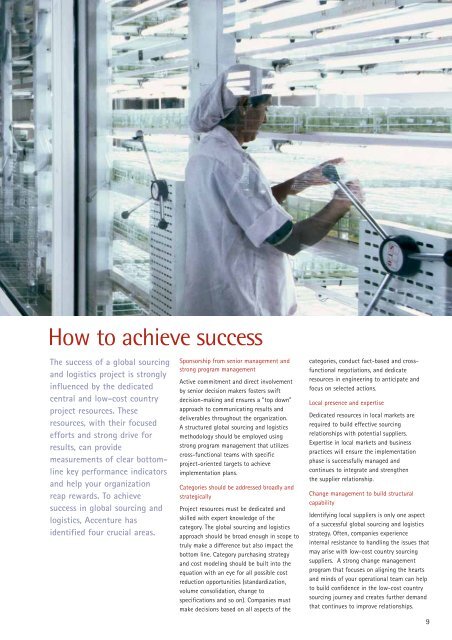Global Sourcing and Logistics
Global Sourcing and Logistics
Global Sourcing and Logistics
You also want an ePaper? Increase the reach of your titles
YUMPU automatically turns print PDFs into web optimized ePapers that Google loves.
How to achieve success<br />
The success of a global sourcing<br />
<strong>and</strong> logistics project is strongly<br />
influenced by the dedicated<br />
central <strong>and</strong> low-cost country<br />
project resources. These<br />
resources, with their focused<br />
efforts <strong>and</strong> strong drive for<br />
results, can provide<br />
measurements of clear bottomline<br />
key performance indicators<br />
<strong>and</strong> help your organization<br />
reap rewards. To achieve<br />
success in global sourcing <strong>and</strong><br />
logistics, Accenture has<br />
identified four crucial areas.<br />
Sponsorship from senior management <strong>and</strong><br />
strong program management<br />
Active commitment <strong>and</strong> direct involvement<br />
by senior decision makers fosters swift<br />
decision-making <strong>and</strong> ensures a "top down"<br />
approach to communicating results <strong>and</strong><br />
deliverables throughout the organization.<br />
A structured global sourcing <strong>and</strong> logistics<br />
methodology should be employed using<br />
strong program management that utilizes<br />
cross-functional teams with specific<br />
project-oriented targets to achieve<br />
implementation plans.<br />
Categories should be addressed broadly <strong>and</strong><br />
strategically<br />
Project resources must be dedicated <strong>and</strong><br />
skilled with expert knowledge of the<br />
category. The global sourcing <strong>and</strong> logistics<br />
approach should be broad enough in scope to<br />
truly make a difference but also impact the<br />
bottom line. Category purchasing strategy<br />
<strong>and</strong> cost modeling should be built into the<br />
equation with an eye for all possible cost<br />
reduction opportunities (st<strong>and</strong>ardization,<br />
volume consolidation, change to<br />
specifications <strong>and</strong> so on). Companies must<br />
make decisions based on all aspects of the<br />
categories, conduct fact-based <strong>and</strong> crossfunctional<br />
negotiations, <strong>and</strong> dedicate<br />
resources in engineering to anticipate <strong>and</strong><br />
focus on selected actions.<br />
Local presence <strong>and</strong> expertise<br />
Dedicated resources in local markets are<br />
required to build effective sourcing<br />
relationships with potential suppliers.<br />
Expertise in local markets <strong>and</strong> business<br />
practices will ensure the implementation<br />
phase is successfully managed <strong>and</strong><br />
continues to integrate <strong>and</strong> strengthen<br />
the supplier relationship.<br />
Change management to build structural<br />
capability<br />
Identifying local suppliers is only one aspect<br />
of a successful global sourcing <strong>and</strong> logistics<br />
strategy. Often, companies experience<br />
internal resistance to h<strong>and</strong>ling the issues that<br />
may arise with low-cost country sourcing<br />
suppliers. A strong change management<br />
program that focuses on aligning the hearts<br />
<strong>and</strong> minds of your operational team can help<br />
to build confidence in the low-cost country<br />
sourcing journey <strong>and</strong> creates further dem<strong>and</strong><br />
that continues to improve relationships.<br />
9

















